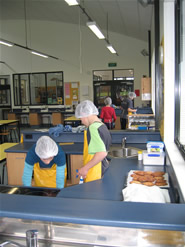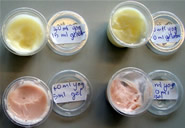Pre-planning
The Toolbox didn't suddenly materialise – the idea had grown over the previous two years. Diana and Carol wanted to replicate the seamless progression, happening in Food Technology from Years 7/8 to 9, through Years 9-12 so that each student beginning Year 13 would have the solid foundation of food technology skills and knowledge required to successfully plan and execute an independent project.
The Toolbox would also provide teachers with information specific to Food Technology. Carol notes that they are often asked the difference between generic Technology knowledge and Food Technology knowledge. She and Diana didn't want to reproduce a Components of Practice-type document, instead the Toolbox aims to encourage teachers to pick it up, use it and test it, to find out if it works for them.
Carol Pound:
"When Food Technology was first introduced, teachers would sometimes focus on skills to use in Technological Practice. But once their students had those good skills they found they didn't have anything to do with them, that they couldn't make the projects any more difficult as the moved up the school. Rather than making planning, brief writing, etc, harder, the Toolbox means students can get new material every year on Food Technology knowledge. They can make their projects technically harder as well as develop those good planning skills, etc. Instead of 'we've done this already' there is always new material they can follow through."
In 2007 Diana and Carol spent four days in the school holidays creating the basis of the Toolbox, ready for term 1. "From our experience of working together, we just sat down and tried to nut out the knowledge that a Year 13 student would need to know in order to do Food Technology at a reasonable level to pass NCEA Level 3" says Carol. "We worked out what we'd been doing, what students needed out of that, and tried to put together a framework it could fit into".
They decided to concentrate on five main topics:
- Food Formulation
- Food Safety and Legislation
- Food Production
- Food Packaging and Labelling
- Food Product Testing
For ease of use these would be organised in the document in two ways under:
- Topic headings to show progression levels, and
- Year levels to show knowledge/skills specific to the level.
To keep things simple, information was mapped onto the year, rather than curriculum level. With three levels of progression – Years 7/8, 9/10, 11/12 – and five topics, a teacher could focus on one topic a term over two years and cover most of the content.
The pair looked at what they'd expect a student coming into Year 13 to know, and what 'tools' they should be able to choose from for use in their project work. Then it was a matter of working out the required progression from Year 7 to that point.

The hardest part in developing the Toolbox was deciding what, from a huge subject area, to leave out. This decision was made by assessing what was reasonable for a student of a particular age to learn. For example, 'sensory' would cover only consumer sensory testing, on the grounds that the more difficult technique of trained panels is more suited to university level education. Carol points out that they'd tried many things over a five-year period, some successful and others not. So it wasn't a situation of starting from scratch and guessing; they already knew what would or wouldn't work.
Carol has 'upskilled' Diana in Food Technology knowledge over the years and, in turn, has learnt from Diana so is now better able to place information into the classroom context. Between them they looked at the information that a food technologist knows, what a teacher knows and what the students need to learn.
Diana and Carol didn't prioritise any of the 'tools'; a teacher would choose what to use, and it could also depend on their students' background in Food Technology. Jacquey's students enter Year 9 with an understanding of the language, some food chemistry, and "a little smattering of everything", whereas students at other schools mightn't have had any experience in it.
Teachers could select the knowledge they wanted to cover, or a project might lend itself to certain parts of the Toolbox. The Toolbox can be used for projects done over a term or a year. Diana teaches the Toolbox in the first term so that her students can apply it to their project later in the term; this means she can plan her use of the Toolbox to fit around the project.
Carol Pound:
"That's its strength, that it is a toolbox, so if you want to use your spanner most of the time that's fine, but you've got to use a screwdriver occasionally to do whatever you have to do. It's not a 'you must teach this' sort of thing, it's just to give guidance."
There are a lot of practical activities that students can do while they're learning, so it's not just theory – if students are learning about a certain functionality of ingredients they need to cook with them to fully understand what is happening.
Teachers can select what they want from the Toolbox. Diana teaches production with a little bit of nutrition, whereas someone else might focus on nutrition – those students will still come out with a good broad comprehension of Food Technology knowledge but with a stronger understanding of nutrition. Carol comments that a teacher enthusiastic about legislation could do a similar thing, with students stronger in that area. "It's not 'you've got to teach all this in five years – go! It's more 'if you're going to teach these areas you need to cover them, but you can still focus on the one you're happy with".



